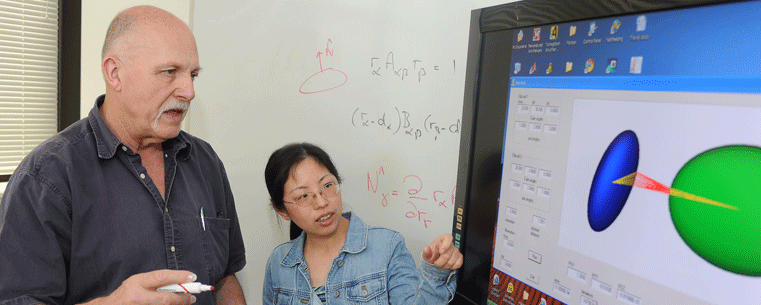Recent Success Stories
- New Kent State President Embarks on Listening Tour
- Scholar Helps Fight Crime With Violence Prevention Research
- Welcome, President Warren
- Destination
Kent
State
Returns - Now Serving More Than 300 Student Organizations
- Visit Kent State
- Kent State Captures Eighth Jacoby Trophy
- Scholar Supplies Global Technology Knowledge to Students

Solving Geometry Problem Yields
Unexpected Benefits
Two Kent State University researchers recently found out that solving an abstract geometry problem can yield unexpected benefits.
In the 1970s, then-graduate student Peter Palffy-Muhoray was obsessed with what he thought would be a simple geometry problem – calculating how close you can bring two ellipses together without one being on top of the other. It turned out to be a much more complicated problem than he originally thought, one that dogged Palffy-Muhoray for more than 25 years.
“I went to liquid crystal conferences and even offered a good bottle of whisky to the theorist who could solve the problem,” said Palffy-Muhoray, now associate director of Kent State University’s Liquid Crystal Institute. “But it turned out nobody succeeded in solving the problem.”
Palffy-Muhoray, who is a professor of chemical physics at Kent State, revisited the problem a few years ago with Xiaoyu Zheng, assistant professor in the university’s Department of Mathematical Sciences, and the pair finally cracked the code.
“We solved the problem in two dimensions in 2006 in just a few months, and then tackled the calculations in 3-D,” Zheng said. The results were published in the respected journal Physical Review E in 2009, and the duo also shared their findings and the code to do the calculations on a Wiki site.
Zheng and Palffy-Muhoray were recently contacted by David Baker, senior geologist with the Chesapeake Energy Corporation of Oklahoma City, Okla. Baker had read about the research online and contacted the pair to express his delight at the findings and to ask for some help. That led to ongoing communication with Zheng that continued into this year.
“My question, which at first I thought was simple, turned into a discourse with Xiaoyu that solved the problem at hand and led to a solution for another,” Baker said. “Chesapeake Energy is the number one driller of horizontal wells in the world, and to preserve the environment, conserve resources and protect correlative rights, we often drill our wells very close to each other from a single drill pad.”
Baker imported the code into his system to modify it for his purposes, but Zheng followed up with him to work through any problems. “We have posted the code for people to use freely, but in a situation like this, we want to make sure that it is interpreted correctly,” Zheng said.
According to Baker, solving the “rather abstract problem” helped his company in a significant way.
It turns out that the uncertainly in the position of wellbores are represented by ellipsoids, and knowing how close these can come together without overlapping helps to avoid collisions. “With a horizontal well costing upwards of $5 million, it is important that our wells never collide,” Baker said. “What originally began as a study of liquid crystals has now been practically applied to drilling gas wells.”
“Drilling technology is very sophisticated now and drilling specialists can control the direction that the drill head moves forward, but not with 100 percent accuracy,” Palffy-Muhoray said. “They need to be certain that the two wells do not come into contact. It is most important that oil companies have all the available resources at hand to make sure that accidents don’t happen.”
Zheng and Palffy-Muhoray received a surprising number of additional inquiries about their calculations. While most were from academia, there were some other unexpected applications that were explored.
“We were contacted by one person who was interested in using the code to help study pedestrian traffic flow assuming, I guess, that people are basically shaped like ellipsoids,” Palffy-Muhoray said. “It’s surprising and very satisfying to note that liquid crystal-based research can have important applications in completely different areas.”
For more information on Kent State’s Liquid Crystal Institute, visit www.lci.kent.edu.

Facebook
Twitter
Google+
LinkedIn
Instagram
YouTube
More Ways to Connect